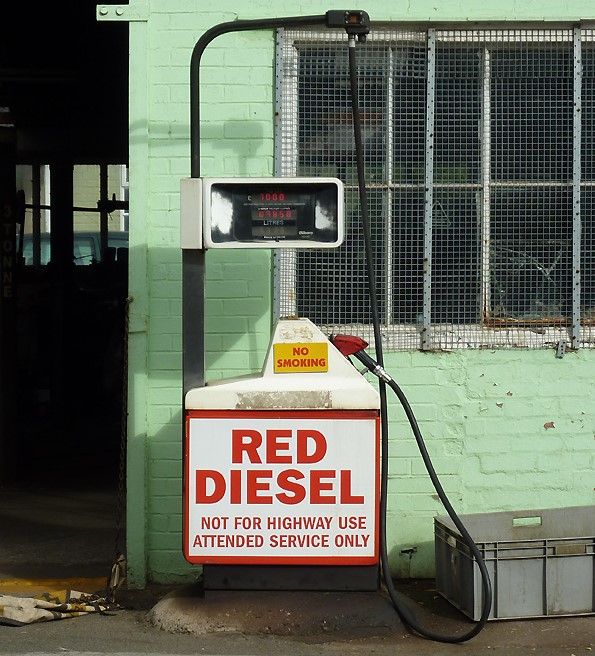Red diesel

|
| This fuel pump dispenses red diesel to patrons who use the fuel for boats, agricultural vehicles or other authorised users. It is not intended for use in standard road-going vehicles. |
Contents |
[edit] Introduction
Red diesel is a type of gas oil (or diesel) that is chemically marked and dyed to prevent it from being used by road-going vehicles. It is most commonly used as a fuel for off-road vehicles and machinery used in construction, agriculture, forestry and fishing. It can also be used for power generation and heating applications.
[edit] Reasons for red diesel
Red diesel is a rebated fuel which is less expensive than white diesel. White diesel (which has no marker or dye) is intended for use in diesel engine road vehicles. It has a fuel duty rate of 57.95 pence per litre (ppl) (2021 level) whereas red diesel is entitled to a rebate of 46.81ppl (2021), giving it an effective duty rate of 11.14ppl.
[edit] Modifications introduced in Budget 2020
In the 2020 Budget, the Government announced that it was removing entitlement to use red diesel from most sectors, other than agriculture, horticulture, forestry, fish farming, rail and non-commercial heating. This change is scheduled to go into effect 1 April 2022.
Businesses losing their entitlement to use red diesel and will need to switch to white diesel. This will include construction, mining and quarrying, ports, manufacturing (e.g. ceramics, steel, timber), haulage (for transport refrigeration units on lorries), road maintenance, airport operations, oil and gas extraction, plant hire, logistics and waste management.
These businesses will need to pay the full duty rate for using white diesel and will therefore experience increased costs. It is hoped that this will encourage fuel users to seek greener alternatives or to use less fuel.
[edit] Anticipated disruptions
One-off costs will include familiarisation with the changes for those sectors no longer entitled, including costs in running down or removing red diesel and rebated biofuels from vehicles, machinery and storage tanks, and possibly from selling back any excess red diesel stock to fuel suppliers. There are also likely to be costs associated with sourcing alternative fuels for those sectors no longer allowed to use rebated fuels.
The Government will aim to reduce some of these familiarisation costs by carrying out further pre-implementation publicity to make businesses aware of the changes, including providing guidance to support businesses to ensure they comply with the new rules. It will also allow some latitude to businesses during the transition, including allowing businesses to use up red diesel taken in before the change, as long as officials can be satisfied that the user has not taken red diesel into the fuel system after the change in rules for usage.
In March 2022 the National Federation of Builders and the Road Haulage Association called for a delay in the removal of the red diesel rebate due to rapidly rising fuel costs. Price rises have resulted from a combination of Covid-19, the subsequent energy crisis and the war in Ukraine. Richard Beresford, chief executive of the NFB, said: “These are unprecedented times and after rejecting industry pleas on minimal exemptions for plant vehicles that could not be electrified, such as mobile cranes, this policy change arrives in the middle of a perfect storm on British energy costs and so a twelve-month deferral on removing the red diesel rebate is pragmatic.”
[edit] Related articles on Designing Buildings
Featured articles and news
RTPI leader to become new CIOB Chief Executive Officer
Dr Victoria Hills MRTPI, FICE to take over after Caroline Gumble’s departure.
Social and affordable housing, a long term plan for delivery
The “Delivering a Decade of Renewal for Social and Affordable Housing” strategy sets out future path.
A change to adoptive architecture
Effects of global weather warming on architectural detailing, material choice and human interaction.
The proposed publicly owned and backed subsidiary of Homes England, to facilitate new homes.
How big is the problem and what can we do to mitigate the effects?
Overheating guidance and tools for building designers
A number of cool guides to help with the heat.
The UK's Modern Industrial Strategy: A 10 year plan
Previous consultation criticism, current key elements and general support with some persisting reservations.
Building Safety Regulator reforms
New roles, new staff and a new fast track service pave the way for a single construction regulator.
Architectural Technologist CPDs and Communications
CIAT CPD… and how you can do it!
Cooling centres and cool spaces
Managing extreme heat in cities by directing the public to places for heat stress relief and water sources.
Winter gardens: A brief history and warm variations
Extending the season with glass in different forms and terms.
Restoring Great Yarmouth's Winter Gardens
Transforming one of the least sustainable constructions imaginable.
Construction Skills Mission Board launch sector drive
Newly formed government and industry collaboration set strategy for recruiting an additional 100,000 construction workers a year.
New Architects Code comes into effect in September 2025
ARB Architects Code of Conduct and Practice available with ongoing consultation regarding guidance.
Welsh Skills Body (Medr) launches ambitious plan
The new skills body brings together funding and regulation of tertiary education and research for the devolved nation.
Paul Gandy FCIOB announced as next CIOB President
Former Tilbury Douglas CEO takes helm.
UK Infrastructure: A 10 Year Strategy. In brief with reactions
With the National Infrastructure and Service Transformation Authority (NISTA).






















